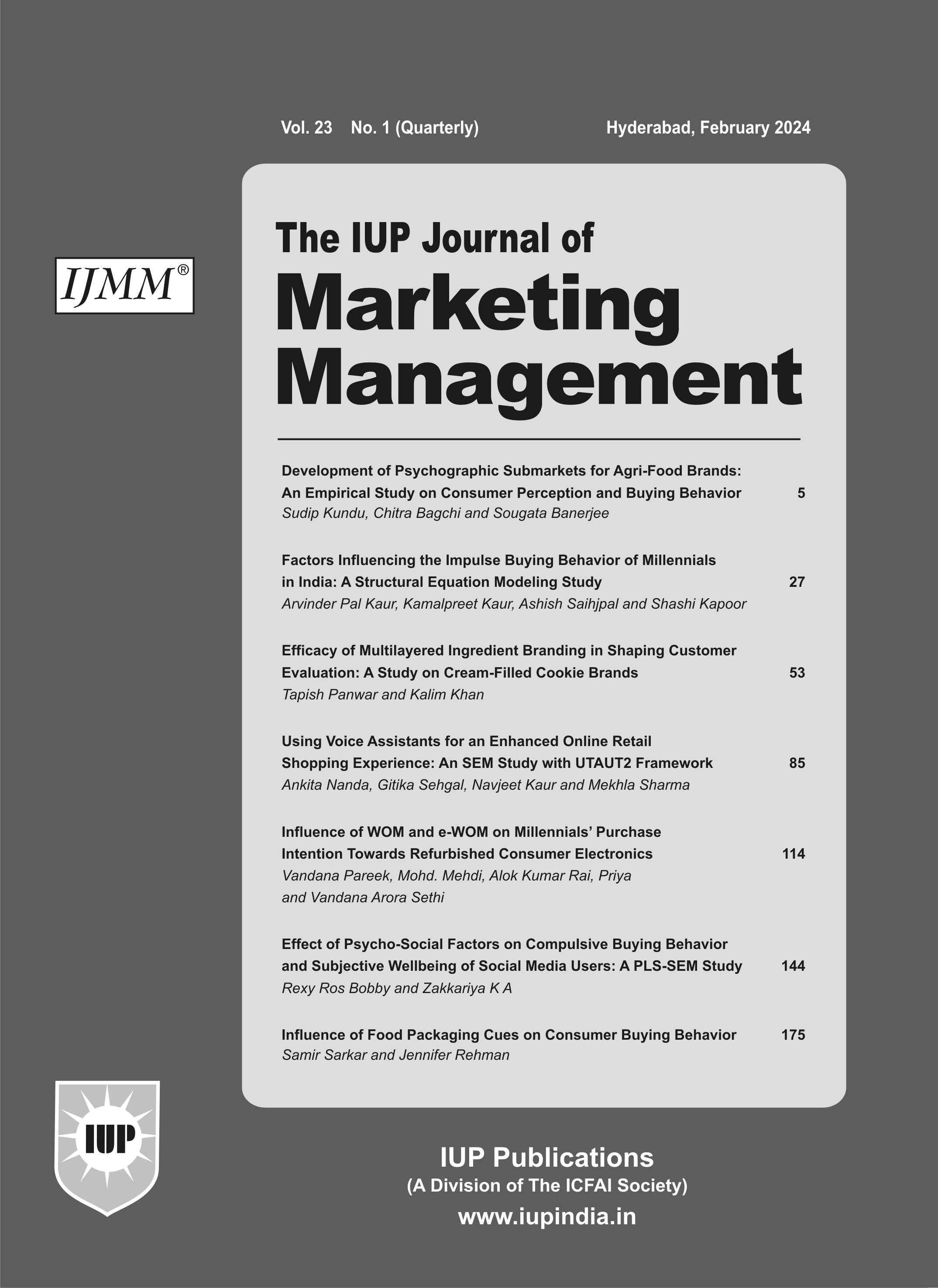
May'23
The IUP Journal of Marketing Management
Archives
Enhancing Consumer-Based Brand Equity Through Social Media Marketing: A Study of Luxury Brands in the Indian Market
The main objective of this paper is to investigate the influence of seven social media functionalities (Identity, Conversations, Sharing, Presence, Relationships, Reputation and Groups) on four components of consumer-based brand equity (Brand Awareness, Brand Association, Perceived Quality, and Brand Loyalty) in relation to luxury brands. Casual research design was used to study the relationship between the latent variables using a sample of 336 young luxury brand consumers in two major Indian cities. The research instrument was adopted from the previous studies, and the measurement model was validated by confirmatory factor analysis. The data was analyzed using the structural equation modeling technique, identifying 24 significant relationships out of 28. This means most of the social media functionalities influence the brand equity components. These findings provide valuable guidelines and implications for business managers in relation to branding on social media networks. The findings would also help both marketers and social media website designers in influencing a brand's success using features of such networks. FullArticle...
Impact of Modern Organized Multi-Brand Retail Trade Stores on Street Vendors in India
The present study analyzes the impact of Modern Organized Multi-Brand Retail Trade (MOMBRT) stores on the livelihood of street vendors in the Indian cities of Hyderabad and Bhubaneswar. The study is based on a primary survey carried out using a structured questionnaire during November 2020 to January 2021 among different categories of street vendors in both the cities. The categorization of street vendors is made on the basis of their business location and types of items they sell. Using pooled regression method and descriptive analysis, the study concludes that street vendors are not affected by MOMBRT stores due to three major reasons: first, MOMBRT stores are at the initial stage of operation confined to tier-I and tier-II cities; second, the street vendors adopt new business strategies to keep their business afloat amid growing competition from the organized retail sector; and third, the market of the informal sector is much higher than the formal sector. As such, the impact on the livelihood of street vendors is negligible. FullArticle...
Antecedents of Fashion Product Purchase Intention: An Empirical Study
The study aims to uncover the key antecedents of fashion product purchase intention. Spirituality, traits of vanity, attitude, Subjective Norms (SNs), and Fashion Consciousness (FC) seem to have a significant effect on purchase intention. Despite the fact that attitude and SNs have been widely explored in previous literature, they have not been investigated with spirituality collectively. In addition, although being an important factor, traits of vanity have not been thoroughly explored. The theoretical underpinning of the conceptual framework is the Theory of Planned Behavior (TPB) and Stimulus-Response (S-R) theory. The results show that the most imperative factor in predicting purchase intention is attitude, followed by spirituality and traits of vanity. The findings may aid marketers in better understanding the consumers and developing appropriate strategies for fashion products. FullArticle...
Predicting Bank Telemarketing Success: A Multi-Country Empirical Perspective
Telemarketing is an integral part of persuasive technology-driven commerce tools that have progressed by virtue of advancements in the digital technology. Currently, telemarketing is adopted for modern commerce settings. The prominence of telemarketing promotion cannot be avoided as it has a positive influence on the overall economy. The current study uses various data modeling techniques to predict the achievement of telemarketing promotion. Data was collected for the study from a Portuguese retail bank from 2008 to 2013. The data consists of 21 features, associated with bank client, product and social-economic attributes that were examined. The study also uses some advanced algorithms that have not been used previously, to forecast the reaction to the telemarketing campaign. The study scrutinizes: 1) which algorithms perform better; and 2) which parameters are superior indicators of the models' performance. The findings reveal that the best Machine Learning model for the telemarketing campaign success prediction is Decision Tree with F1-score of 0.5936 and L-measure of 0.5634. Bank managers should use the Decision Tree model to gain definite insights on the behavior of prospective bank customers. FullArticle...
Factors Influencing Purchase Intention of Rural Consumers for Green FMCG Products
he demand for eco-friendly products is increasing globally, which has created a new form of consumer, i.e., green consumer. However, targeting them is very challenging for marketers, because green consumers want companies to engage in various environment-friendly practices such as recycling, waste management, energy efficiency, etc. Apart from this, there are various factors which influence their intention to purchase green products. The study explores such factors that influence rural consumers to buy green Fast Moving Consumer Goods (FMCG) products. It also investigates the link between factors influencing buying of green FMCG products and purchase intention. Applying factor analysis, 10 factors were explored, out of which eight had significant relationship with the purchase intention of rural consumers with regard to green FMCG products. FullArticle...
Subdimensions of Smart Servicescape: Empirical Evidence Using Confirmatory Factor Analysis
The rapid expansion of e-commerce and rise in digital sales can be traced to a myriad of factors, including digitization of the economy and availability of low-cost Internet access. For the purpose of this study, the term "smart servicescape" is used to refer to various aspects of online physical environment. The study seeks to provide empirical evidence of the various subdimensions of smart servicescape using confirmatory factor analysis. The study shows that aesthetics, social presence, superior functionality, perceived interactivity, personalization and smart payment have valid variances and good model fits in the creation of a smart servicescape. FullArticle...